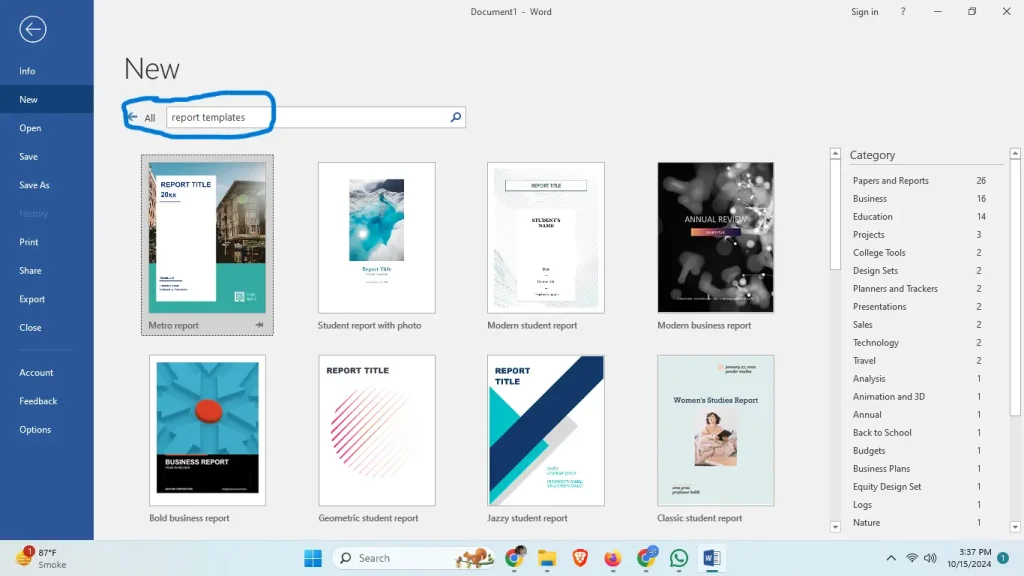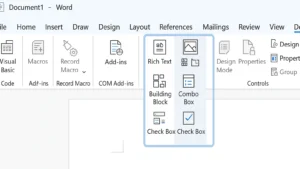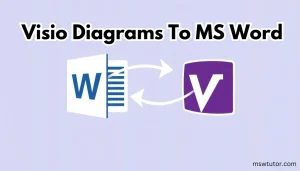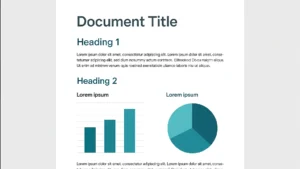Last Updated: January 24, 2025
Using templates for reports makes creating a professional document much easier. Microsoft Word templates save you time and make your reports look polished. Let’s see how these templates can make your report-writing process simpler.
Table Of Contents
- 1 Why Use Templates for Reports in Microsoft Word?
- 2 How to Use Templates for Reports in Microsoft Word
- 3 Frequently Asked Questions About Using Microsoft Word Templates
- 4 Tips for Customizing Microsoft Word Templates
- 5 Benefits of Using Microsoft Word Templates for Reports
- 6 How to Access More Templates
- 7 Common Mistakes to Avoid When Using Templates
- 8 Conclusion
Why Use Templates for Reports in Microsoft Word?
Templates are here to make your life easier, especially when you need to write a report. Imagine you have to make an important report, and the deadline is close. Instead of starting from scratch and worrying about the layout, you can open Microsoft Word, pick a template, and start adding your content. Whether it’s a school assignment, a business report, or a financial statement, templates give you a ready-made structure to start quickly. According to a Microsoft survey, people who use templates spend 60% less time formatting documents, which is super helpful when you’re in a rush.
What makes templates so useful?
- Save Time: Instead of spending hours on formatting, you can focus on the content. Microsoft Word templates come with pre-made headings, tables, cover pages, and text boxes, so you save time and keep things consistent.
- Look Professional: First impressions count. Templates make sure your report looks organized, consistent, and professional. You don’t need to worry about text alignment or choosing fonts—it’s all done for you.
- Customize to Your Needs: Microsoft Word templates are easy to customize, so you can change things like colors, fonts, and layouts to match your style or brand.
How to Use Templates for Reports in Microsoft Word

Using templates is simple. Here’s how:
- Open Microsoft Word: Start by opening Microsoft Word. Go to the “File” menu and select “New.” Learn more about downloading templates from Office.com
- Search for Templates: Browse the featured templates or use the search bar to look for specific report templates—just type “report template” and see what comes up.
- Choose and Customize: Once you find a template you like, click on it to open. You can then customize it—change the colors, add your logo, or switch fonts.
- Add Your Information: Now you just need to fill in your data. The templates have marked areas, making it easy to add content without messing up the formatting.
Frequently Asked Questions About Using Microsoft Word Templates
- Are Microsoft Word Templates Free?
Yes, many templates are free. Microsoft Word offers templates for reports, resumes, newsletters, and more. Check out some of the best Microsoft Word templates for resumes here If you want more options, there are also premium templates available with Microsoft 365 or on other websites. - Can I Create My Own Template?
Yes! You can create your own template by setting up a document the way you want and saving it as a “.dotx” file. Learn more about creating custom templates in Microsoft Word This way, you can use the same layout for future reports. - What Types of Report Templates Are Available?
There are many types of templates: business reports, annual reports, school reports, research reports, and more. Each one is designed for different needs, whether you need data visuals, a formal layout, or interactive elements like a table of contents. - How Can I Make My Report Stand Out Using Templates?
Customizing is important. You can add your branding elements, like a logo or specific colors, and include charts and graphics to make your report more engaging.
Tips for Customizing Microsoft Word Templates
- Use Consistent Colors: Choose colors that match your brand or the purpose of your report.
- Add Relevant Visuals: Use charts, graphs, or images that help explain your data.
- Edit Styles: Change headings and paragraph styles to fit your needs and save these changes for later use.
Benefits of Using Microsoft Word Templates for Reports
1. Save Time and Reduce Stress
According to a survey by TechRadar, 75% of professionals say using templates makes report writing less stressful. Read more on TechRadar With all the formatting done for you, you can focus on the content.
2. Make Collaboration Easier
If you’re working with a team, templates make it easy for everyone to follow the same formatting. This avoids mistakes and keeps everything looking consistent.
3. Stay Consistent
If you’re making multiple reports, using the same template helps keep the style and formatting consistent, making your work look more professional.
How to Access More Templates
If the built-in templates aren’t enough, you can check out websites like Template.net, Microsoft Word built-in templates, Envato Elements, and Microsoft’s online template gallery. These sites have lots of high-quality templates for all kinds of reports.
Common Mistakes to Avoid When Using Templates
- Not Customizing Enough: Templates are just a starting point. Make sure to change the default text and colors to avoid a generic look. Tip: Add your branding, like a logo and specific colors, to make the report unique.
- Inconsistent Branding: Adjust fonts, colors, and logos to match your brand. Tip: Create a style guide to keep branding consistent across your reports.
- Ignoring Readability: Break up long paragraphs, use bullet points, and add visuals to make your report easier to read. Tip: Use headings to organize content logically.
Conclusion
Using templates for reports in Microsoft Word is one of the easiest ways to make your work faster and more professional. Templates save time, reduce stress, and make it easy for teams to collaborate, so you can focus on delivering great content. With the tips in this guide, you can choose, customize, and create effective reports with ease.
Next time you need to create a report, don’t start from scratch. Use Microsoft Word templates to save time and ensure a polished, professional result.





